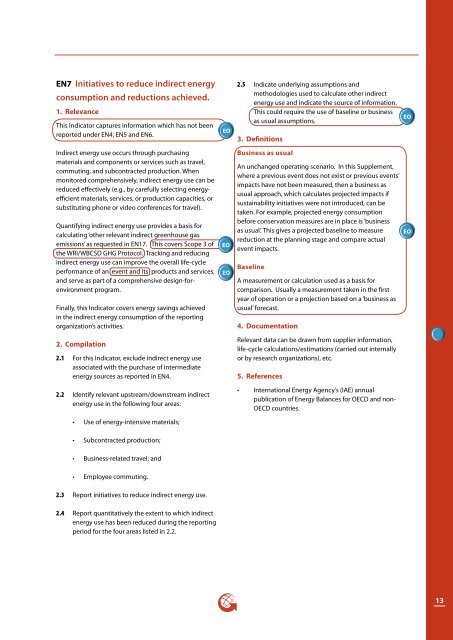Event Organizers Sector Supplement - Global Reporting Initiative
Event Organizers Sector Supplement - Global Reporting Initiative
Event Organizers Sector Supplement - Global Reporting Initiative
Create successful ePaper yourself
Turn your PDF publications into a flip-book with our unique Google optimized e-Paper software.
EN7 <strong>Initiative</strong>s to reduce indirect energy<br />
consumption and reductions achieved.<br />
1. Relevance<br />
This Indicator captures information which has not been<br />
reported under EN4, EN5 and EN6.<br />
EO<br />
2.5 Indicate underlying assumptions and<br />
methodologies used to calculate other indirect<br />
energy use and indicate the source of information.<br />
This could require the use of baseline or business<br />
as usual assumptions.<br />
3. Definitions<br />
EO<br />
Indirect energy use occurs through purchasing<br />
materials and components or services such as travel,<br />
commuting, and subcontracted production. When<br />
monitored comprehensively, indirect energy use can be<br />
reduced effectively (e.g., by carefully selecting energyefficient<br />
materials, services, or production capacities, or<br />
substituting phone or video conferences for travel).<br />
Quantifying indirect energy use provides a basis for<br />
calculating ‘other relevant indirect greenhouse gas<br />
emissions’ as requested in EN17. This covers Scope 3 of<br />
the WRI/WBCSD GHG Protocol. Tracking and reducing<br />
indirect energy use can improve the overall life-cycle<br />
performance of an event and its products and services,<br />
and serve as part of a comprehensive design-forenvironment<br />
program.<br />
Finally, this Indicator covers energy savings achieved<br />
in the indirect energy consumption of the reporting<br />
organization’s activities.<br />
2. Compilation<br />
2.1 For this Indicator, exclude indirect energy use<br />
associated with the purchase of intermediate<br />
energy sources as reported in EN4.<br />
2.2 Identify relevant upstream/downstream indirect<br />
energy use in the following four areas:<br />
• Use of energy-intensive materials;<br />
EO<br />
EO<br />
Business as usual<br />
An unchanged operating scenario. In this <strong>Supplement</strong>,<br />
where a previous event does not exist or previous events’<br />
impacts have not been measured, then a business as<br />
usual approach, which calculates projected impacts if<br />
sustainability initiatives were not introduced, can be<br />
taken. For example, projected energy consumption<br />
before conservation measures are in place is ‘business<br />
as usual’. This gives a projected baseline to measure<br />
reduction at the planning stage and compare actual<br />
event impacts.<br />
Baseline<br />
A measurement or calculation used as a basis for<br />
comparison. Usually a measurement taken in the first<br />
year of operation or a projection based on a ‘business as<br />
usual’ forecast.<br />
4. Documentation<br />
Relevant data can be drawn from supplier information,<br />
life-cycle calculations/estimations (carried out internally<br />
or by research organizations), etc.<br />
5. References<br />
• International Energy Agency’s (IAE) annual<br />
publication of Energy Balances for OECD and non-<br />
OECD countries.<br />
EO<br />
• Subcontracted production;<br />
• Business-related travel; and<br />
• Employee commuting.<br />
2.3 Report initiatives to reduce indirect energy use.<br />
2.4 Report quantitatively the extent to which indirect<br />
energy use has been reduced during the reporting<br />
period for the four areas listed in 2.2.<br />
13

















